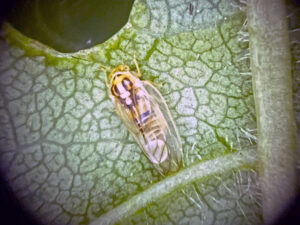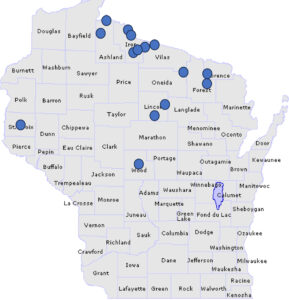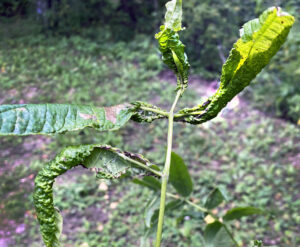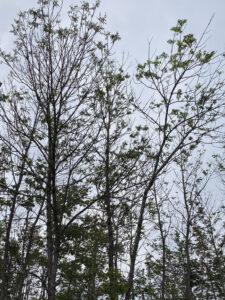
Adult psyllids are quite small and can blend in with their surroundings. / Photo Credit: Linda Williams, Wisconsin DNR
By Linda Williams, DNR Forest Health Specialist, Woodruff;
Linda.Williams@wisconsin.gov or 920-360-0665
Have you noticed black ash trees that have tightly curled leaves in scattered clumps, with lots of bare areas on the branches?
The problem might be cottony ash psyllid (Psyllopsis discrepans), a tiny, sap-sucking insect that has been in North America for almost 100 years but was first identified in Wisconsin in 2006. Its presence was reconfirmed in 2023, when it was found in several additional counties around the state. Since then, it has been identified in even more counties.
Feeding by cottony ash psyllid causes leaves to curl and twist. They will look clumpy on the tree instead of the normal, “flat” foliage that moves with the wind. Cottony ash psyllid feeds on black ash (and closely related ash species, such as Manchurian ash). Green and white ash are avoided.

Map of known cottony ash psyllid infestations in Wisconsin. / Map Credit: Linda Williams, Wisconsin DNR
An infestation can cause tree decline and eventual mortality. Since 2000, several communities in Canada have experienced significant issues with cottony ash psyllid.
Some Canadian provinces have observed that psyllid numbers explode during dry periods. It was quite dry in Wisconsin in 2023, which might have allowed the population to grow in numbers and geographic spread.
The insects produce two generations per year. They use piercing, sucking mouthparts to draw the sap from leaves, which causes curling and puckering as well as early leaf drop. Damaged leaves may be severely stunted, or so tightly curled that they appear as bumpy tubes.
A close look at the underside of curled leaves will often reveal nymphs, adults or both, depending on the time of year. Nymphs feed on the lower surfaces of the leaves, where they cover themselves with cottony, waxy material. Adults resemble leafhoppers and can jump, which gives them their other common name: “jumping plant lice.”
There are several other issues that can cause problems in black ash:

Feeding by the invasive insect cottony ash psyllid causes ash tree leaves to pucker and curl. / Photo Credit: Linda Williams, Wisconsin DNR
- Woolly ash aphid or ash leaf curl aphid can also cause leaf curling and puckering, but they do not cause branch dieback or tree mortality.
- The ash flower gall mite can cause male ash flowers to curl and grow into odd, clumpy balls that remain on the trees for a year or more.
- Ash anthracnose is a leaf disease that can cause rapid loss of leaves in the spring. However, the tree will produce a second set of leaves, so infection usually doesn’t cause dieback or mortality.
- Ash yellows causes a slow decline of the crown of the tree, and trees will often develop “witches’ brooms” – a type of epicormic branching (new shoots growing from a dormant bud lying beneath the bark). This is an indicator of significant stress, which can eventually lead to the tree’s death.
- Finally, of course, there’s emerald ash borer, which can kill all our native ash trees.

Patchy and clumpy foliage are evident on a tree being impacted by cottony ash psyllid. / Photo Credit: Linda Williams, Wisconsin DNR
Control options for cottony ash psyllid are still being evaluated. Various studies are underway to identify what will work best. Cities are scrambling to find ways to keep their trees alive. Unfortunately, by the time damage is noticeable, the trees may be too stressed or compromised to adequately take up systemic insecticides. Because the nymphs feed on the undersides of the tightly curled leaves, they are somewhat protected from foliar spray application, so it’s important to time sprays for when the adults are out and mating. Treating lowland black ash forests with systemic insecticides is not practical.
